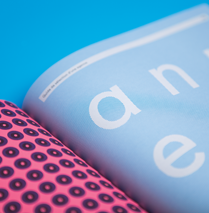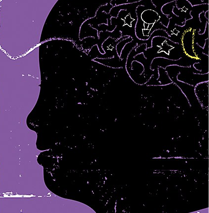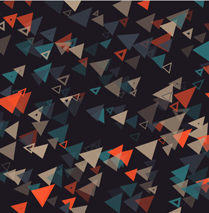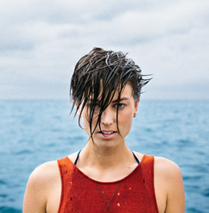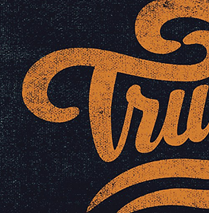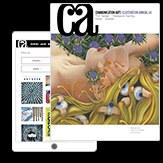How did you get started in digital design and learn the skills necessary for the medium? I used to work for a big digital production company, specifically as an assistant director to a creative director. I had a background as a photographer and a videographer, so I brought those skills to the job and learned how to apply interactivity to visual content.
What was the impetus that led you to establish your creative studio MONOGRID? My partners and I used to work for international clients at our previous job, but the market in Italy wasn’t ready yet, and there were no studios specializing in interactive storytelling. That’s why we decided to found MONOGRID and bring our knowledge into the field.
Tell us about the Talent District, the Istituto Marangoni’s metaverse space for its fashion design students and educators. How did you leverage existing technology to create this educational platform on Web 3.0? I believe that students need to try out as much technology as possible that they study in the books. That’s the reason why, together with the Istituto, we decided to build a metaverse platform for them as a place to learn and to showcase their work, a place where everybody can test out the new medium and experiment with new technology. Students can make virtual fashion collections, explore interactive environments and go to virtual events with this platform. It also provides a space for students to connect with each other and with industry professionals from around the world.
Using Web 3.0 technologies—such as blockchain and decentralized storage—the platform provides a more immersive and interactive learning environment for students and, in a few years, a more secure and decentralized storage for student work. For example, blockchain technology could give students safe digital identities. Decentralized storage solutions could store and share files such as 3-D models and high-resolution images, keeping them both accessible and secure.
Overall, the Talent District is an innovative example of how virtual worlds and Web 3.0 technologies can create new educational opportunities and experiences.
How was it adapting WIRED magazine’s NextFest for a digital space and turning its history of covers into NFTs? The project needed a collaborative, creative approach, and our team stepped up to the challenge by looking into cutting-edge technologies like AI and Midjourney to make digital experiences that were truly unique. From the design of the space environment to the unique reworking of the covers to bring NFTs to life from the prompt that described the original ones. We pushed the boundaries of what is possible in the digital realm, and the results were truly spectacular. The project not only showcased the skills and creativity of our team, but also demonstrated the power of technology and transformed the way we create and experience art.
As more brands adapt to and create phygital experiences on the metaverse, what would you say makes those experiences effective? How can interaction and web designers adapt their creative processes to work with this emerging media trend? In today’s rapidly evolving digital landscape, it’s essential for interaction and web designers to continuously hone their skills and knowledge to keep pace with emerging media trends. By prioritizing creativity, technical proficiency and user-centered design principles, these professionals can craft innovative, impactful designs that resonate with audiences and drive engagement. Through ongoing learning, experimentation and collaboration with other industry experts, interaction and web designers can stay ahead of the curve and create digital experiences that truly stand out.
One project I particularly enjoy is the immersive 3-D e-commerce experience you created for spirits brand Engine Gin, in which you created an interactive, gas station–inspired retail experience on the web. Do you think similar e-commerce experiences could become more commonplace on the web? I believe a brand needs to be unique across all its platforms. Engine, being a small brand, can experiment more than others and create a unique experiences for its customers. It was also interesting to apply gamification mechanisms to the e-commerce experience. Our goal was clear from the start, which has to represent the essence of the brand. The idea of creating a gas station came from the fact that Engine already spoke a visual language related to the automotive industry. The most interesting thing, in my opinion, is how we managed to associate the real elements found in the space: for example, the fridge, the vending machine and the counter—with a retro-but-digital look and feel—with an active function within the website. Each hotspot tells something different and is crucial to the 360-degree experience. The focus was to be able to create an environment that speaks for the brand, leveraging both the aesthetics and the functionality of these objects.
Aside from phygital and web experiences, MONOGRID has also created AR apps for clients like HBO’s House of the Dragon. What are some of the unique challenges and opportunities you see in AR, and what was it like creating an AR experience based on a TV show? We think that AR is the future of marketing stories. It’s one of the most advanced technologies, and everyone can use it on their phones. Creating the game for House of the Dragon was at once challenging and rewarding. We achieved amazing technical results after nine months of work. We used Niantic, which let us create features within the app that could not have existed otherwise. For example, the recognition of the type of environment the user is in adds an extra layer of realism to the experience, or all the incredible work we did with AI to make it possible for voice recognition of commands that could be given to the dragon in its various stages of growth.
What tools do you find indispensable for your work? Google, Pinterest and Google Slides.
What emerging technologies and innovations will have the biggest impact on how you design in the next few years? Here are some key technologies that will influence how designers approach digital marketing: AI is a rapidly evolving technology that is already changing the way marketers approach digital marketing. AI can automate repetitive tasks, analyze data and gain insights into how customers act. This helps marketers make more personalized campaigns and get customers more involved.
AR and VR technologies are becoming more sophisticated and accessible, providing new opportunities for designers to create immersive experiences that capture customers’ attention and build brand loyalty.
Voice search is becoming more popular because smart speakers and voice assistants are becoming more popular. As a result, designers will need to create content that is optimized for voice search, such as natural language queries and schema markup, to help search engines better understand the content.
Blockchain technology has the potential to revolutionize digital advertising by providing a more secure and transparent way to track and verify ad impressions, reducing fraud, and increasing trust between advertisers and publishers.
With the rollout of 5G networks, download and upload speeds will be faster, latency will be lower, and connections will be more reliable. This will open up new possibilities for high-bandwidth, real-time experiences like live video streaming, VR and AR.
If designers keep up with these new technologies, they will be better able to create campaigns that grab customers’ attention and make them loyal to their brand.
Do you have any advice for people just starting out in the field of interactive design? I always invite my students to experiment as much as possible with new tools and try out as many digital experiences as possible, even if those experiences are not “their style.” It’s important to know all the ways digital and interactive design can be used. In my view, there are a few basic aspects that everybody interested in interaction design should follow.
• Develop a strong foundation in design principles: Interactive design is built upon a foundation of traditional design principles such as layout, typography, color theory and user experience design. Make sure you have a solid understanding of these principles before diving into more advanced interactive design techniques.
• Stay up-to-date with the latest technologies: Interactive design is constantly evolving, and it’s important to keep yourself informed of the latest tools and technologies. Follow relevant blogs and news sources, attend conferences and meetups, and participate in online communities to stay on top of the latest trends.
• Focus on user experience: Interactive design is ultimately about creating experiences that are intuitive, engaging and enjoyable for users. To be successful in this field, you need to have a deep understanding of user behavior and psychology and be able to design experiences that meet users’ needs and expectations.
• Practice, practice, practice: The more you design and prototype, the more you will learn about what works and what doesn’t. Don’t be afraid to experiment and take risks. Even if your designs fail, you will learn valuable lessons that will help you improve your skills and refine your approach.
• Collaborate with others: Interactive design is often a team effort, so it’s important to be able to work effectively with others. This means being open to feedback, listening to others’ perspectives, and being willing to compromise and make adjustments based on others’ input.
• Keep an open mind: Interactive design is a constantly changing field; what works today may not work tomorrow. Be open to new ideas and approaches, and be willing to adapt and evolve your skills as needed to stay relevant and effective in this exciting, dynamic field.
• Build a strong portfolio: Your portfolio is your best marketing tool as an interactive designer, so make sure it showcases your best work and demonstrates your skills and expertise. Include a variety of projects that showcase your range of skills and abilities. ca



